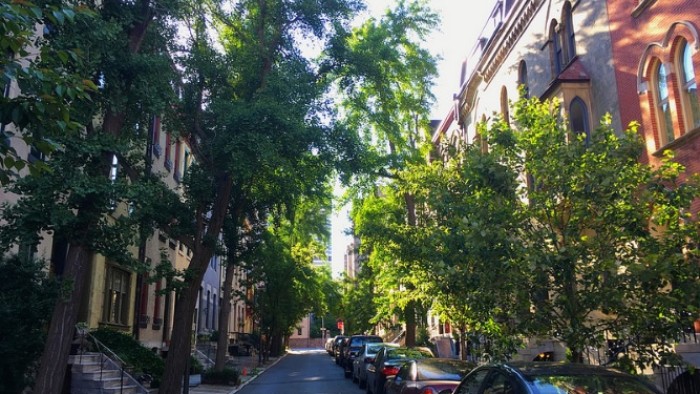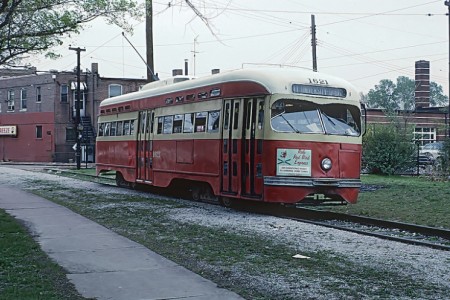How Green Infrastructure Yields Urban Safety and Health

This is Part 2 of a two-article series. The first article was published in August.
Greenprint Partners is field-testing a green infrastructure-financing approach that could help make communities healthier and safer in a small group of Rust Belt cities. In an interview, Nicole Chavas, the company’s CEO and cofounder, and Rose Jordan, its marketing director, said the models have expansion potential. If adopted on a larger scale, they could improve the quality of life in many low-to-moderate-income urban neighborhoods.
In the big picture, there are many communities that could benefit from this kind of work. So far, Greenprint Partners – formerly known as Fresh Coast Capital – has active or potential projects in Youngstown, Peoria, St. Louis, and Philadelphia.
CFN: When one looks at the promises that are being made at the federal level about infrastructure modernization, one can see they sometimes encounter roadblocks. But people are talking about earmarking more money for infrastructure revamps in general. What are your thoughts about the role that green infrastructure could play if that financing hits the ground?
Chavas: Green infrastructure is cost-effective, it’s adaptable, and it’s sustainable. And as the climate changes and our infrastructure continues to deteriorate, it’s really the future of water infrastructure.
Right now, we have centralized systems that are outdated. 772 cities have sewers that combine their stormwater sewers with their sanitary sewers. So when it rains heavily, raw sewage is discharged into waterways.
Green infrastructure is a way to help manage water at the surface and do it in a sustainable way that adds substantial value to the community.
[This is] unlike big gray infrastructure projects that are underground where no one can see they exist.
The community impacts of green infrastructure go beyond that. For example, there’s research documenting the impacts of green space on crime, health and cohesion. There are so many additional benefits. What you get for the investment in green infrastructure adds so much value to the community.
CFN: What is the research you’ve seen related to health, crime and cohesion?
Jordan: A quick Google search reveals dozens of peer-reviewed articles linking green infrastructure to better outcomes for communities. University of Washington’s College of the Environment published a literature review of research related to urban greening and crime reduction.
For example, a study in Baltimore that showed an increase in tree canopy had a corresponding decrease in crime in those neighborhoods where they planted trees.
Another study showed that green infrastructure built around housing projects reduces the levels of domestic violence.
Willamette Partnership has also published the Green Infrastructure and Health Guide that illuminates the links between green infrastructure and health outcomes. For example, there are studies that tie green infrastructure to reduced respiratory illness and asthma.
Reduced stress and anxiety levels is another [topic].
CFN: In the communities where you’re working, what are some of the health and social issues that are there?
Jordan: A lot of those studies of the impacts of green infrastructure are in Philadelphia, where we’re currently working to help anchor institutions in lower-income, majority-minority neighborhoods access green infrastructure grants. All it takes is to input the addresses where we’re working in Philadelphia into the United States Environmental Protection Agency’s Environmental Justice Screening and Mapping Tool to see the types of challenges these communities are up against.
Chavas: Youngstown’s another great example. The green infrastructure master planning we’re doing in Youngstown is based on our benefits-driven design process. We’ve identified the key benefits the city and community care about, which include health and safety.
For example, there are specific design principles that address crime concerns. You wouldn’t want to go into a neighborhood where there are safety concerns and plant a bunch of bushes where people feel unsafe. You would want to be thoughtful about the types of trees that you plant, how far apart they are, and the types of sightlines they create.
You can give people increased health and safety just by design. These are the kinds of tools we use and the resources we leverage when thinking about how to design and create green infrastructure for those specific needs.
CFN: There are a couple different financing models you’re using for these projects. How would you describe them using language that is easy for our readers to understand?
Chavas: What we do is that we deliver high-impact green infrastructure all the way from initial planning to installation and long-term maintenance.
And the way we think about it is – how can we help take that model and provide that capacity to community? And what financial structures will really make that seal?
Given the early stages of green infrastructure, we need to be creative – the way we were in St. Louis. We use creative financing to create a structure and bring capital into those neighborhoods.
[In a situation like this,] we’ve got access to an existing Water Authority program. There’s money available. But because of staffing and cash-flow barriers, low-income communities in particular are just not able to take advantage of it.
And so that’s why our presence [in St. Louis] is driving a more equitable distribution of funds.
And what we did in Peoria, citywide, was to look at private-public partnerships and [see] how they can bring new innovative sources of financing to create structures and really achieve their goals.
We’re looking at public-private-partnership-investment structures that can help those cities achieve those goals by [using] impact-driven financing to [help with] the upfront costs of design, construction and validation and then really lock in that long-term maintenance as well.
That’s one thing I should mention about green infrastructure. It’s only effective if it’s done at scale and is maintained for the long term. Obviously, it’s nature. And if you don’t maintain nature, it’s going to stop performing and it’s going to stop retaining that water.
So that’s a critical element of how we think about these structures. What can be done to ensure these projects are maintained in the long term?
CFN: What do you mean by long-term maintenance, exactly?
Chavas: With the St. Louis private-landowner program that I described earlier and the one in Philadelphia, the landowner partners make a commitment to the long-term maintenance.
And we give them the tools to ensure they are able to do that by training their maintenance staff or just providing them with a toolkit.
We help make sure they are set up to do this long-term maintenance by providing the tools to ensure they are able to train their existing maintenance staff or access specialists as needed. And they make that commitment to the water authority to take advantage of this program to do that long-term maintenance.
What we’re envisioning for the long-term public-private partnerships is that this entire lifecycle of green infrastructure from design to construction to validation to long-term maintenance would be contracted upfront.
In 30-year-agreement with a city, all of those elements are holistically designed and planned for and contracted upfront. They know that for the long term, these properties are going to be guaranteed to be maintained.
We know there is a long-term revenue stream in terms of paying for the services of green infrastructure that can attract that financing.
CFN: So how would you describe your process of partnering with government and public organizations to leverage public capital?
Chavas: It’s very unique working with public partners because everyone’s a little bit different.
One of the challenges of green infrastructure is that the incentives and the stakeholders involved are unique from city to city or from water authority to water authority.
What are the things that are fairly common from government authority to government authority? And what things are unique to those specific municipalities? Those are some things we’re working through.
We think that each additional city we work with provides us with credibility and a new understanding about what it means to work with a municipality that we can take to other municipalities. It’s all about learning how to work under those frameworks.
Where there are existing programs, like in St. Louis, we work within that existing structure. But when we work with Youngstown, where green infrastructure is relatively new, we’re an early-stage thought partner and we’re to them early on in helping them shape their vision for green infrastructure.
Jordan: It’s really about looking at where that municipality or water authority is at in terms of stormwater regulations and goals, identifying how green infrastructure can deliver more value than the alternative in setting or delivering other goals for infrastructure and seeing how it can be of value to them and then going from there.
CFN: How do you plan to measure the results you accomplish?
Chavas: We have some basic metrics that all of the projects will measure. The base one is gallons of water – the water that is no longer running off into the sewer system and into waterways.
And then we’ll also track the locations of these properties. Are they in low-income communities? Are they serving low-income communities?
[We’ll measure] the number of community members we engage throughout the process. We usually hold a number of community design meetings to engage people throughout the design. We track how many people attend them and how many are residents of the community.
How can we bring in additional data? How can we track impact? How can we track social factors? Over time, we may be able to bring in other types of health and social data. How can we track social factors?
But for now, we’re starting with the metrics that are easiest to capture and most readily available and meaningful for the purpose of managing stormwater.
To comment on this article, please post in our LinkedIn group, contact us on Twitter, or use our contact form.
